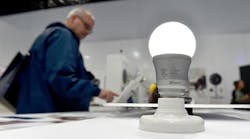The National Electrical Manufacturers Association (NEMA), Rosslyn, VA, released its 2017 second quarter lamp indices this week putting some numbers to the market-share growth of LED lighting and continuing shifts in more traditional categories.
LED A-line lamp shipments decreased 14.3% in 2Q 2017 compared to 1Q 2017. However, LED A-line lamps continued a year-over-year climb increasing 13.8% compared to 2Q 2016. Halogen shipments posted a quarter-to-quarter increase in 2Q 2017 compared to 1Q 2017, increasing by 5.9%. Incandescent shipments remained virtually flat compared to last quarter with a 0.1% increase. CFL lamps posted a quarter-to-quarter decrease of 6.8%. Incandescent, halogen and CFL lamp shipments all decreased in a year-over-year comparison of 2Q 2017 to 2Q 2016, decreasing 31.1%, 23.4% and 33.1%, respectively.
Halogen A-line lamps now account for 47.5% of the consumer lamp market, followed by LED A-line lamps at 28.8%. CFLs and incandescent split the remaining 2Q 2017 consumer lamp market accounting for 13.0% and 10.7%, respectively. Incandescent A-line lamp sales now largely consist of 15W and 25W lamps.
NEMA's shipment index for high intensity discharge (HID) lamps posted a decline in shipments in 2Q 2017 compared to 2Q 2016. Mercury vapor posted a 13.9% decline, metal halide was down 23.9% and sodium vapor down 9.3%. Quarter-over-quarter results also declined with metal halide declining 14.8% and sodium vapor and mercury vapor posting decreases of 2.8% and 6.8%, respectively, in 2Q 2017 compared to 1Q 2017.
In market-share terms, metal halide lamps still dominate HID with 58.8% of the market in 2Q 2017, while sodium vapor and mercury vapor account for 37.1% and 4.1%, respectively.
In the linear world, the linear florescent lamp index continues a downward trend: T5 (-9.3%), T8 (-10.5%) and T12 lamps (-8.1%) all posted a quarter-over-quarter decreases for 2Q 2017 compared to 1Q 2017. The index for T8 lamps, which account for 57.3 percent of the consumer lamp market, decreased on a year-over-year basis by 26.9% in 2Q 2017 compared to 2Q 2016. T5 and T12 shipments also continued their declines by 26.8% and 24.0%, respectively year-over-year.
NEMA said its Business Information Services (BIS) has added T-LED shipments to the market penetration graph to begin tracking their impact on the market. When more historical data is available T-LED shipments will be added to the index. In 2Q 2017 T-LEDs accounted for 21.7% of the florescent lamp shipments. T5 lamps account for 8.6% of the 2Q 2017 market and T12 lamps 12.4%.
The NEMA lamp indices are composite measures of member companies’ U.S. shipments of a variety of lamp types. The report is designed to track underlying demand for these types of lamps.



